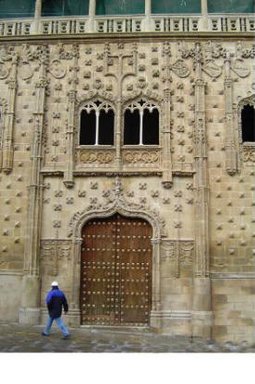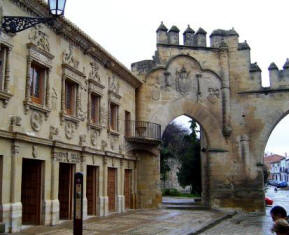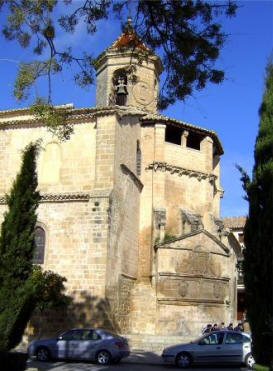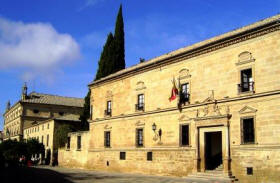
Costa del sol bjuder på många dina utflyktsmål.
Läs om mina förslag på vackra bergsturer.
Välkommen till min webbsida som handlar om trivsamma platser i Europa, utflykter i Andalusien och sköna promenader i Stockholm.
Klicka på det som intresserar dig!
Trevlig läsning
ROWS OF OLIVE GROVES AS FAR AS THE EYE CAN SEE
ÚBEDA AND BAEZA

E5, A4 (north: exit 268 La Carolina; south: exit 292 Bailén /68 km/
(If you are heading south towards Granada – Málaga, drive towards Jaén from Baeza and the detour will only be 37 km.)
In a landscape of never-ending, billowing rows of silver-green olive trees, pedantically planted in a strictly geometrical pattern, we find the two twin towns of Baeza and Úbeda. This district has the highest yield of olives and olive oil in the world, and it is all produced in the old, traditional way.
Already during Roman times olive oil was produced in this region. A good way to find out more about this golden liquid is to visit the olive oil museum in Hacienda de la Laguna in Puente del Obispo which is between Baeza and Jaén.
A JOINT HISTORY
The two towns of Úbeda and Baeza lie only nine kilometres apart and have a lot in common. The Roman name for Baeza was Beatia and it was a prominent Visigothic town which later became the capital of an Arabic kingdom. Úbeda is first to be found in the registers of the Arabic era, when it was called Obdah. It was a very important town in those days and is mentioned in the Muslim history of the religious wars. Both towns had Christians and Moorish citizens living side by side until 1227, when Fernando III led the final invasion of the area. After that the two towns led an uneasy existence for nearly three centuries, precariously positioned between the Christians in the north and the Moorish kingdom of Granada.
RENAISSANCE THE DOMINATING ARCHITECTURAL FEATURE
When the Moors were finally defeated at the end of the 15th century and an upswing in agriculture and textile production took place, both towns were blessed with a long period of prosperity and peace. In the 16th century, at the height of the Renaissance, the aristocrats of the two towns were competing with each other in the building of splendid palaces and the construction of the odd church or monastery, hoping to ensure themselves a place in Paradise. This would explain the great accumulation of renaissance style buildings in these two towns, tucked away in the middle of rural Andalusia.
MONUMENTAL UNITY IN ÚBEDA
No fewer than 500 buildings are listed as historical monuments in Úbeda. So do go out on a little tour of discovery, preferably in the evening, when the houses are lit up and you could easily fancy yourself suddenly whisked back in time by about four centuries! Plaza de Vázques de Molina and its nearest surroundings is the most significant of the monumental areas. Here, clustered together in a fairly small area, is an interesting assortment of renaissance palaces and other buildings, almost all of them the work of the architect Andrés de Vandelviras. Special mention should be given to Palacio del Condestable Dávalos, today a parador hotel, with a beautiful inner quadrangle, and Palacio de las Cadenas, where nowadays the Town Hall is housed. Hospital de Santiago, a hospital from the 16th century, is another very notable renaissance building. Two beautiful churches from the 13th and the 16th centuries adorn the square as well. Should it be time to turn in for the night, why not go for a truly stately type of accommodation in this town of palaces? Here are two alternatives: the Parador, of course, but Palacio de la Rambla in Plaza del Marqués also offers night-quarters.


MY FAVOURITE, BAEZA
If you were to ask me which one of the two towns I prefer, it would have to be Baeza. It is the smaller of the towns where the monumental quarters appear more naturally alive, somehow. We have the Plaza del Pópulo with its tourist office housed in a grand old palace. Diagonally opposite is the old slaughterhouse from the 16th century, contained in a beautiful renaissance building, belying the trivial purpose of the house. In the middle of the square stands a decorative fountain, Fuente de los Leones, with an ancient Iberian-Roman statue of Imilce, wife of Hannibal. Its head has been replaced, however, as the original was chopped off during the civil war by an enraged mob, thinking it was a statue of the Virgin Mary. Other notable buildings are La Antigua Universidad, a renaissance- and baroque building, seat of one of Spain’s first universities between the years 1542–1825, and Palacio de Jabalquinto, a magnificent Gothic palace with a richly ornamented façade. Around the corner is Plaza Santa Maria with a fountain in the shape of a little triumphal arch and here stands also the impressive Gothic cathedral, erected on the orders of Ferdinand III in the place of an Arabic mosque. In 1567 the cathedral was then subjected to a comprehensive reconstruction carried out by the architect Vandelvira.
A RAVISHING VIEW

From this spot you could work your way out of the old district and go in search of Paseo de las Murallas, there to admire the fantastic view over the Guadalquivir valley with nothing but olive trees in rows for miles on end and magnificent mountain ranges as a striking backdrop. Here is, then, the financial source of all those grand palaces. Even today olive plantation is a lucrative business, thanks in no small way to the generous EU subsidies, which have led to the value of the land increasing considerably during the last decade. Now of course tourism, too, is flourishing, contributing to the welfare of the region, and Úbeda and Baeza have certainly made good use of their treasures. New hotels and restaurants add to the cheerful atmosphere, and the old buildings have been given a proper face-lift.
Palacio de Jabalquintos, Baeza, with its richly ornamented gothic façade
The winding lanes of Baeza
Plaza del Pópulo, Baeza
Iglesia de San Pablo in Úbeda
The parador in Úbeda in a grand
old palace